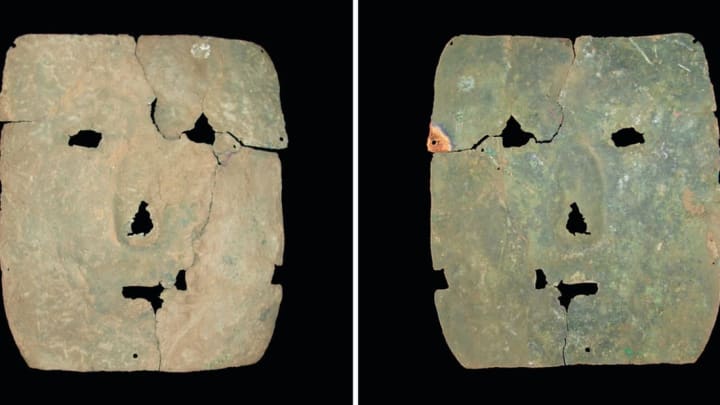A good downpour can be an archaeologist’s best friend. A recent rainy season in the northwest corner of Argentina revealed an ancient copper mask, green with rust, that had been hidden in the dirt for the last 3000 years. It's the oldest known copper artifact in the Andes—the longest continental mountain range on earth—and one of the oldest metalworks ever found in South America. Its discovery complicates the long-standing idea that metalworking began on the continent in Peru, thousands of miles north.
The mask looks a bit like a Jack-o’-lantern, with a little triangle for a nose and small openings for the eyes and mouth. Residents of the village of La Quebrada stumbled across the mask, as well as some bones, sticking out of the dirt in 2005. Shortly after, archaeologists came in to excavate the site, and they found that the mask wasn’t resting on just one burial, but was covering a collective grave with 14 bodies.
“We don’t know exactly what the actual meaning of the mask was in the context of this pre-Hispanic society,” archaeologist Leticia Inés Cortés, of Argentina’s National Council for Scientific and Technical Research, tells Mental Floss. Ancestor cults are very ancient and widespread in the region, Cortés says, so the mask could be a representation of the ancestor of the group and the rest of their community. Later DNA tests might reveal the relationships between the deceased.
The burial site was located near the 1900-year-old settlement of Bordo Marcial. However, radiocarbon dates showed that the tomb and mask are much older—dating back to 3000 years ago, before any villages even existed in the region.
During this time period, people in the area were just beginning to leave their hunter-gatherer way of life. But even before they truly settled down and started farming, they apparently figured out how to take advantage of the rich copper sources in the region that are still mined today.
Cortés, who described the mask in a new report in the journal Antiquity, tells Mental Floss that there’s been a tendency to treat Peru as the epicenter for technological innovation in the region. This mask, meanwhile, shows “that there is no one place for technological innovation, but many, including this region of the southern Andes.”
In other words, it’s not like a few geniuses in the central Andes figured out how to melt down metal to make beautiful objects and their invention spread from there.
Archaeologists might have previously assumed that cultures only started making fine metal objects when they had elite ruling classes and a capacity to create agricultural surpluses to free up time for skilled workers. But the mask from Argentina also builds on other evidence from the region demonstrating that displays of wealth might pre-date sedentary life.
“The discovery underscores the idea that social complexity—that is, a hierarchical social order—is not required for the emergence of early metal working,” says Mark Aldenderfer, an archaeologist at the University of California, Merced, who wasn’t involved in the study.
Aldenderfer previously discovered the oldest gold artifacts in the Americas, in the form of a necklace dating back to 4000 years in Peru near Lake Titicaca, when people in that region were just starting to settle into villages.
“The circulation of metal artifacts and their interment with the dead suggest that new forms of wealth accumulation and networking began to emerge during this transitional period,” Aldenderfer tells Mental Floss. "I suspect that the copper mask from Bordo Marcial reflects a similar social context."
